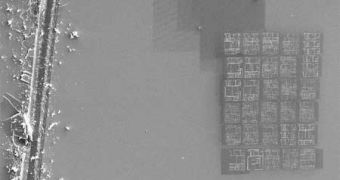Just recently, the world's smallest book was published by Robert Chaplin at the Nano Imaging Facility of Simon Fraser University.
This book, complete with an International Standard Book Number (ISBN-978-1-894897-17-4), is entitled "Teeny Ted From Turnip Town". It was written by Malcolm Douglas Chaplin and is a fable concerning the success of Teeny Ted from Turnip town and his victory in the Turnip contest at the annual county fair.
It is at present the world's smallest published book.
And boy, is it small. How small is it? So small you need an electron microscope to read it. In fact, for it to be intelligible to the naked eye, it has to be magnified 8 000 times.
The book, a children's story written by Malcolm Douglas Chaplin and called Teeny Ted from Turnip Town, was created over four months by SFU physicists Karen Kavanagh and Li Yang. Measuring an infinitesimally tiny 0.07 millimeter-by-0.1 millimeter, it is composed of 30 carved tablets linked side by side. And if you want to get an idea of just how small 0.07 millimeters-by-0.1 millimeter is, consider that the head of a pin is about two-by-two millimeters.
So far only one copy of Teeny Ted from Turnip Town, a fable about Teeny Ted's victory in the turnip contest at the annual county fair, has been produced, but there are plans to create 99 more - providing there are orders for them.
The cost: $20,000 each, and you have to provide your own electron microscope.
The way they did it was to direct atoms of gallium, one of the elements on the periodic table which is liquid at room temperature, at a polished piece of single crystalline silicon.
In other words, the gallium was the ink and the silicon was the paper.
"When you put gallium atoms in a vacuum chamber and ionize them by applying a large electric field, you can form an ion beam of gallium atoms that then can be focused with electrostatic lenses onto whatever you want to change or modify," Kavanagh explained. "It's like sending little bullets of gallium on to the surface and that removes other atoms as they go."
But small as the book is - by comparison, a Massachusetts Institute of Technology version of the King James Bible produced in 2001 was five-by-five millimeters, while a copy of Chekhov's Chameleon produced in 2002 was 0.9-by- 0.9 millimeters - it's by no means as small as a book can be.
Can you imagine what they want to do next? Of course, an even smaller book, ten times smaller than the one they've just produced.

 14 DAY TRIAL //
14 DAY TRIAL //